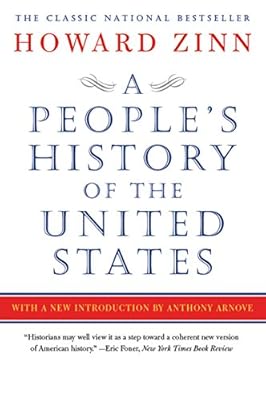📚 node [[a people s history of the united states]]
- Author:: [[Howard Zinn]]
- Full Title:: A People's History of the United States
- Category:: [[books]]

-
Highlights first synced by [[readwise]] [[September 2nd, 2020]]
- When we read the history books given to children in the United States, it all starts with heroic adventure—there is no bloodshed—and Columbus Day is a celebration. (Location 734)
- it is the job of thinking people, as Albert Camus suggested, not to be on the side of the executioners. (Location 788)
- this book will be skeptical of governments and their attempts, through politics and culture, to ensnare ordinary people in a giant web of nationhood pretending to a common interest. (Location 799)
- “The cry of the poor is not always just, but if you don’t listen to it, you will never know what justice is.” (Location 802)
- “No poorhouses are needed among them, because they are neither mendicants nor paupers. . . . Their kindness, humanity and courtesy not only makes them liberal with what they have, but causes them to possess hardly anything except in common.” (Location 990)
- “Thus power was shared between the sexes and the European idea of male dominancy and female subordination in all things was conspicuously absent in Iroquois society.” (Location 1001)
- Children in Iroquois society, while taught the cultural heritage of their people and solidarity with the tribe, were also taught to be independent, not to submit to overbearing authority. They were taught equality in status and the sharing of possessions. The Iroquois did not use harsh punishment on children; they did not insist on early weaning or early toilet training, but gradually allowed the child to learn self-care. (Location 1002)
- Columbus and his successors were not coming into an empty wilderness, but into a world which in some places was as densely populated as Europe itself, (Location 1021)
- African slavery lacked two elements that made American slavery the most cruel form of slavery in history: the frenzy for limitless profit that comes from capitalistic agriculture; the reduction of the slave to less than human status by the use of racial hatred, with that relentless clarity based on color, where white was master, black was slave. (Location 1137)
- There is an enormous difference between a feeling of racial strangeness, perhaps fear, and the mass enslavement of millions of black people that took place in the Americas. The transition from one to the other cannot be explained easily by “natural” tendencies. It is not hard to understand as the outcome of historical conditions. (Location 1217)
- the number of arriving whites, whether free or indentured servants (under four to seven years contract), was not enough to meet the need of the plantations. (Location 1220)
- As in any contract between unequal powers, the parties appeared on paper as equals, but enforcement was far easier for master than for servant. (Location 1443)
- Through all that growth, the upper class was getting most of the benefits and monopolized political power. (Location 1570)
- in 1687 there were, out of a population of six thousand, about one thousand property owners, and that the top 5 percent—1 percent of the population—consisted of fifty rich individuals who had 25 percent of the wealth. By 1770, the top 1 percent of property owners owned 44 percent of the wealth. (Location 1571)
- The country therefore was not “born free” but born slave and free, servant and master, tenant and landlord, poor and rich. (Location 1585)
📖 stoas
- public document at doc.anagora.org/a-people-s-history-of-the-united-states
- video call at meet.jit.si/a-people-s-history-of-the-united-states
⥱ context
← back
(none)
(none)
↑ pushing here
(none)
(none)
↓ pulling this
(none)
(none)
🔎 full text search for 'a people s history of the united states'